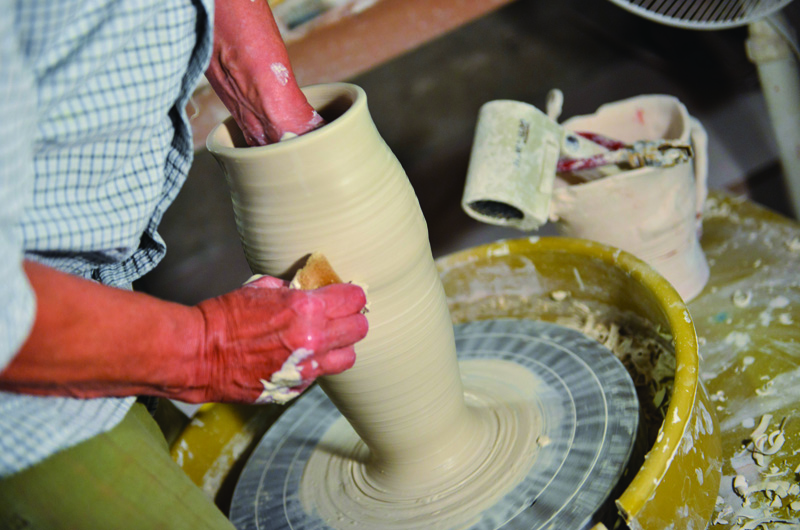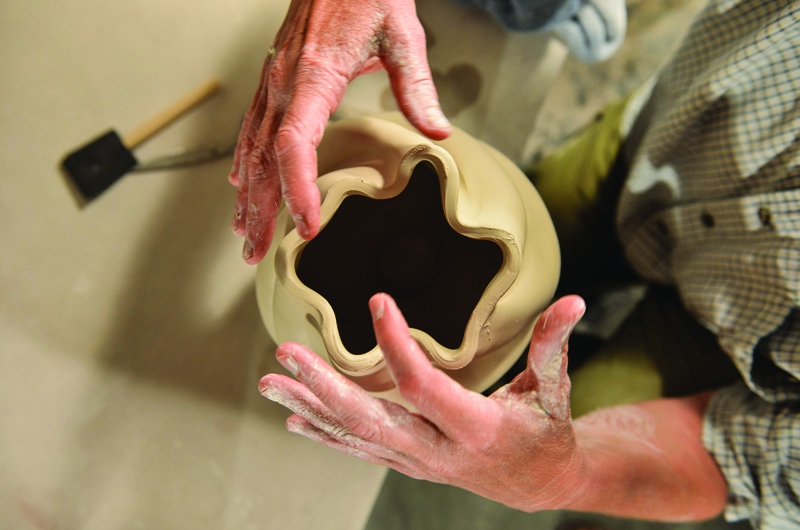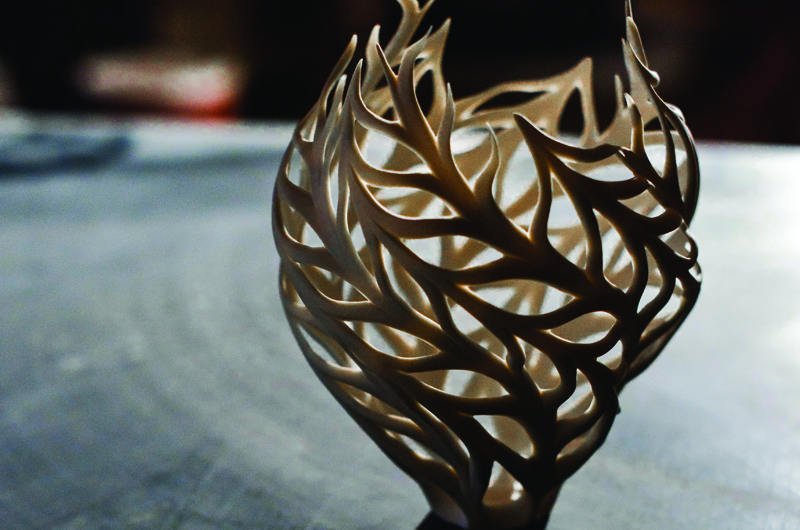There’s a kind of alchemy at work in Jennifer McCurdy’s Vineyard Haven basement studio, where she creates porcelain objects of extraordinary fineness, delicacy, and beauty out of what is essentially a pile of dirt.
A skilled ceramic artist, her work has been shown by numerous galleries around the United States. Through donations by collectors, some of McCurdy’s pieces also have found their way into museums, including the Museum of Fine Arts in Boston, the Brooklyn Museum in New York, and the Smithsonian’s Renwick Gallery in Washington, D.C.
Having thrown her first pot in a high school ceramics class in Birmingham, Michigan, and made a living as a potter for thirty-five years – the last twenty of them on Martha’s Vineyard – McCurdy says her goal now is to become an eighty-five-year-old artist. “I think I’ll always be excited about this work,” she says, adding that there are so many different directions she’d love to follow that even given three lifetimes, she’d never get to try them all.
Perhaps for that same reason, she’s inspired to teach other potters her trade. “I want to let people know everything possible about what I do,” she says. “I don’t want all these techniques I’ve found out about to die with me.”
There is fluid quality to her work, which somewhat belies the fact that the process is precise, requiring her to work quickly and with exactitude through various stages: wedging (or kneading) her clay, throwing a vessel on a potter’s wheel, altering the vessel’s shape, carving the vessel, and finally, firing it.
But there are also necessary pauses in the process – to let a thrown pot dry, to wait for the kiln to do its blistering work – so that from beginning to end a work might take two weeks to complete if McCurdy is working flat out, longer if a piece is complex and needs more time to dry. In preparation for our studio visit, she has set up her home potting studio as a chef might set up a kitchen for a television cooking show, doing the equivalent of pre-chopping and partially cooking her ingredients. There are pots in all stages of development, ready for her to demonstrate how she works on them at each juncture.
It’s time to teach. But first, a word of caution. “The skill you develop as a potter or musician, you get through practice,” she says. “It’s like in the game of handball, where the first thing you have to do is throw the ball at the wall, and then you see how it comes back at you and do your best to try to hit it.”
Potter up.
Wedging
McCurdy begins by showing me her clay, which comes in twenty-five-pound blocks, two to a box. Porcelain is composed primarily of a soft, white clay called kaolin, named for a hill in China where it was mined for centuries. There are thousands of recipes for porcelain clay. McCurdy’s is about half kaolin – a fine variety called Grolleg that is mined in the United Kingdom – and half a variety of minerals such as feldspar, along with added plasticizers, which increase a material’s flexibility.
The first, she says, is wedging, in which clay is kneaded on a porous surface to draw out some of the moisture, break up bubbles (which can cause the clay to explode during firing), and remove hard spots. After decades of hand-wedging her clay, McCurdy found that she was beginning to wear down the muscles in her hands, so a few years ago she purchased a clay wedging machine. Large, loud, and industrial in appearance, the machine not only saved her hands but also changed her entire potting process.
“I throw my clay very stiff,” she says, meaning with relatively little water in it. “When you’re going to go horizontal, as I do to get these very spherical forms, it requires a lot of strength in the clay, and you have to throw very stiff. This machine wedges it as stiff as I want it, just perfectly.” Also, she notes, working with stiffer clay led her to throw thinner pots, which affected her carving and firing.
“It changed everything,” she says. “I’ve had to relearn some things, and do some things differently, which has taken my work to another level. I have more folds in the clay now; it’s more airy, and I love that.”
Throwing
Once the clay is wedged, she removes a cylindrically shaped chunk of it from the wedging machine and places it in the center of her potter’s wheel. Using a foot pedal to regulate the wheel’s speed, she centers her clay, and with wet hands begins to shape it. Making a hole in its center leads to the beginnings of a vessel with an inside and an outside. Using two small, sharp scrapers called “ribs,” one on the inside and one on the outside, she coaxes out the sides of the vessel, creating convexity. In surprisingly little time, she has completed a pot. She sets it aside, and we move onto the next stage in her process: altering the vessel.
Altering
McCurdy unveils a previously thrown pot that she has wrapped in plastic to preserve the precise texture to which she has dried it; it is leathery, tough but malleable. Turning the pot in one hand, she uses the other to etch curving, vertical lines into its surface. These are her guidelines, describing the preliminary patterning of the pot. Next, she presses into these lines with a stylus, creating creases that become like valleys between curving hummocks. The pot’s shape is no longer smooth but undulating. It has been “altered.”
“Altering is a bit like origami,” she says, “the Japanese art of paper folding.”
Carving
McCurdy carves the “folded” vessel, cutting out shapes in a pattern. She works quickly and without hesitation, because she is racing against time. Soon the pot will dry to a point where carving will become more difficult, if not impossible.
“It’s the nature of clay,” she says. “I have to work quickly, while the clay progresses from wet to dry, doing everything exactly when I’m supposed to. I have to have a complete understanding of the whole range, knowing when I need to slow down and let a piece continue to dry before I proceed, and when I need to arrest the drying. It’s very precise.”
The finished pots have an organic look to them, like flowers or leaves, or perhaps seaweed. They are not meant to be exactly representational. “I would be defeated if I tried to copy nature’s patterns,” she says. “I just try to think the way nature thinks and have the work flow from there. But,” she adds, “because of the repetition of pattern in my work, I hope that my pieces look more grown than made.”
Firing
Firing porcelain requires white hot heat, and McCurdy’s kiln operates at 2,350 degrees Fahrenheit. Because of this extreme temperature and the delicacy of the pieces, firing often changes them.
“Sometimes a piece comes out of the kiln looking radically different from how it looked when I put it in,” she says. “When this happens, I’ve learned not to immediately think poorly of it. Instead, I’ll put it aside for a month, and then see whether my preconceived idea of what it should be has changed, and often it has. . . . This has happened to me with such regularity that I try never to think in terms of ‘mistakes.’ That’s what we tell kids, right? That there are no such things as mistakes, only things that you learn.”
Of course, there are always exceptions. “Sometimes I just take a hammer to them,” she says.
Afterward
What goes into the kiln as gray clay emerges as pure white porcelain, thin and translucent. If you hold a piece up to light and run your finger along the back side, you will see the shadow of your finger through the ceramic. Fired porcelain is non-porous, meaning that even unglazed, it will hold water without absorbing it, as a glass vessel does. “I’m working with light and shadow and the various qualities of light such as translucency, hard shadow, and soft shadow,” she explains. “A number of years ago I found that glazing detracted from this.” She stopped glazing, but recently enlisted her husband to gild the insides of some of her creations. “I was looking for that light source that pure gold seems to have inside it,” she says. Being opaque and reflective, the gold blocks the porcelain’s natural translucency, however. “It’s a tough choice to make sometimes.”
The good thing is there are no really wrong choices. As McCurdy says, she can always throw a new ball at the wall and see how it comes back.







